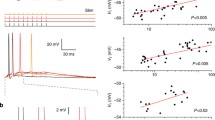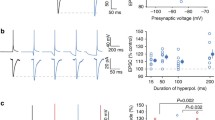Abstract
Compared with regular-spiking (RS) neurons, the action potentials (APs) of fast-spiking (FS) neurons are characterized by narrow spike durations and unusually fast decay dynamics of dV/dt process. However, quantitative measure of accurate sodium and potassium densities accounting for spike shape in the axon initial segment (AIS) where action potentials are initiated in both RS and FS cells is not well explored. Here, axonal recordings showed that the averaged axonal spike half-height duration of RS cells is significantly larger (Matlab anova1, \(p < 0.001\)) than that of FS cells. The averaged dV/dt ratio of RS cells is significantly lower (Matlab anova1, \(p < 0.001\)) than that of FS cells. We have reproduced axonal APs by cortical Hodgkin–Huxley axonal models constrained by a set of experimentally observed properties of RS and FS cells. The model predicts that sodium channel conductance \({g}_{\mathrm{Na}}\) in RS AIS is in a range of 1000–4000 pS/\(\upmu \text {m}^{2}\) and potassium channel conductance \({g}_{\mathrm{K}}\) is in a range of 30–200 pS/\(\upmu \text {m}^{2}\) in order to produce energy-efficient RS action potentials with major properties matching experimental observations of pyramidal cells. The model predicts that \({g}_{\mathrm{Na}}\) is within 1000–2500 pS/\(\upmu \text {m}^{2}\) and \({g}_{\mathrm{K}}\) ranges within 300–1000 pS/\(\upmu \text {m}^{2}\) for AIS of FS cells. The AP duration and efficiency are nonlinearly regulated by the ratio of \({g}_{\mathrm{Na}}/{g}_{\mathrm{K}}\). We performed patch-clamp recordings on both RS and FS cortical axons and observed that \({g}_{\mathrm{Na}}\) was approximately \(1620.4\pm 770\,\hbox {pS}/\upmu \text {m}^{2}\) for RS AIS and \(803.7\pm 351.5\,\hbox {pS}/\upmu \text {m}^{2}\) for FS AIS. The \({g}_{\mathrm{K}}\) was \(189.6\pm 75.8\,\hbox {pS}/\upmu \text {m}^{2}\) for the RS AIS and \(524.6\pm 281.6\,\hbox {pS}/\upmu \text {m}^{2}\) for the FS AIS. Partial drug-mediated inhibition of sodium or potassium channels significantly decreases or enlarges the AP duration and dV/dt ratio of both RS and FS cells, respectively, suggesting that sodium and potassium conductance density in cortical axons may be critical in determining the dynamical features of AP profiles in FS and RS cells.








Similar content being viewed by others
References
Alle, H., Geiger, J.R.: Combined analog and action potential coding in hippocampal mossy fibers. Science 311(5765), 1290–1293 (2006). https://doi.org/10.1126/science.1119055
Alle, H., Roth, A., Geiger, J.R.: Energy-efficient action potentials in hippocampal mossy fibers. Science 325(5946), 1405–1408 (2009). https://doi.org/10.1126/science.1174331
Attwell, D., Laughlin, S.B.: An energy budget for signaling in the grey matter of the brain. J. Cereb. Blood Flow Metab. 21(10), 1133–1145 (2001). https://doi.org/10.1097/00004647-200110000-00001
Bender, K.J., Trussell, L.O.: Axon initial segment \(\text{ Ca }^{2+}\) channels influence action potential generation and timing. Neuron 61(2), 259–271 (2009). https://doi.org/10.1016/j.neuron.2008.12.004
Bhattacharjee, A., Kaczmarek, L.K.: For \(\text{ K }^{+}\) channels, \(\text{ Na }^{+}\) is the new \(\text{ Ca }^{2+}\). Trends Neurosci. 28(8), 422–428 (2005). https://doi.org/10.1016/j.tins.2005.06.003
Carter, B.C., Bean, B.P.: Sodium entry during action potentials of mammalian neurons: incomplete inactivation and reduced metabolic efficiency in fast-spiking neurons. Neuron 64(6), 898–909 (2009). https://doi.org/10.1016/j.neuron.2009.12.011
Cauli, B., Audinat, E., Lambolez, B., Angulo, M.C., Ropert, N., Tsuzuki, K., Rossier, J.: Molecular and physiological diversity of cortical nonpyramidal cells. J. Neurosci. 17(10), 3894–3906 (1997)
Coggan, J.S., Sejnowski, T.J., Prescott, S.A.: Cooperativity between remote sites of ectopic spiking allows afterdischarge to be initiated and maintained at different locations. J. Comput. Neurosci. 39(1), 17–28 (2015). https://doi.org/10.1007/s10827-015-0562-8
Colbert, C.M., Johnston, D.: Axonal action-potential initiation and \(\text{ Na }^{+}\) channel densities in the soma and axon initial segment of subicular pyramidal neurons. J. Neurosci. 16(21), 6676–6686 (1996)
Colbert, C.M., Pan, E.: Ion channel properties underlying axonal action potential initiation in pyramidal neurons. Nat. Neurosci. 5(6), 533–538 (2002). https://doi.org/10.1038/nn857
Connors, B.W., Gutnick, M.J.: Intrinsic firing patterns of diverse neocortical neurons. Trends Neurosci. 13(3), 99–104 (1990). https://doi.org/10.1016/0166-2236(90)90185-D
Eyal, G., Mansvelder, H.D., de Kock, C.P., Segev, I.: Dendrites impact the encoding capabilities of the axon. J. Neurosci. 34(24), 8063–8071 (2014). https://doi.org/10.1523/JNEUROSCI.5431-13.2014
Foehring, R.C., Lorenzon, N.M., Herron, P., Wilson, C.J.: Correlation of physiologically and morphologically identified neuronal types in human association cortex in vitro. J. Neurophysiol. 66(6), 1825–1837 (1991)
Gibson, J.R., Beierlein, M., Connors, B.W.: Two networks of electrically coupled inhibitory neurons in neocortex. Nature 402(6757), 75–79 (1999). https://doi.org/10.1038/47035
Gupta, A., Wang, Y., Markram, H.: Organizing principles for a diversity of GABAergic interneurons and synapses in the neocortex. Science 287(5451), 273–278 (2000)
Hasenstaub, A., Otte, S., Callaway, E., Sejnowski, T.J.: Metabolic cost as a unifying principle governing neuronal biophysics. Proc. Natl. Acad. Sci. USA 107(27), 12329–12334 (2010). https://doi.org/10.1073/pnas.0914886107
Hestrin, S., Armstrong, W.E.: Morphology and physiology of cortical neurons in layer I. J. Neurosci. 16(17), 5290–5300 (1996)
Hines, M.L., Carnevale, N.T.: The NEURON simulation environment. Neural Comput. 9(6), 1179–1209 (1997)
Hodgkin, A.L., Huxley, A.F.: A quantitative description of membrane current and its application to conduction and excitation in nerve. J. Physiol. 117(4), 500–544 (1952)
Hu, H., Jonas, P.: A supercritical density of Na(+) channels ensures fast signaling in GABAergic interneuron axons. Nat. Neurosci. 17(5), 686–693 (2014). https://doi.org/10.1038/nn.3678
Hu, W., Tian, C., Li, T., Yang, M., Hou, H., Shu, Y.: Distinct contributions of Na(v)1.6 and Na(v)1.2 in action potential initiation and backpropagation. Nat. Neurosci. 12(8), 996–1002 (2009). https://doi.org/10.1038/nn.2359
Huguenard, J.R., Hamill, O.P., Prince, D.A.: Sodium channels in dendrites of rat cortical pyramidal neurons. Proc. Natl. Acad. Sci. USA 86(7), 2473–2477 (1989)
Ilin, V., Malyshev, A., Wolf, F., Volgushev, M.: Fast computations in cortical ensembles require rapid initiation of action potentials. J. Neurosci. 33(6), 2281–2292 (2013). https://doi.org/10.1523/JNEUROSCI.0771-12.2013
Inda, M.C., DeFelipe, J., Munoz, A.: Voltage-gated ion channels in the axon initial segment of human cortical pyramidal cells and their relationship with chandelier cells. Proc. Natl. Acad. Sci. USA 103(8), 2920–2925 (2006)
Kaczorowski, G.J., Knaus, H.G., Leonard, R.J., McManus, O.B., Garcia, M.L.: High-conductance calcium-activated potassium channels; structure, pharmacology, and function. J. Bioenerg. Biomembr. 28(3), 255–267 (1996)
Kole, M.H., Ilschner, S.U., Kampa, B.M., Williams, S.R., Ruben, P.C., Stuart, G.J.: Action potential generation requires a high sodium channel density in the axon initial segment. Nat. Neurosci. 11(2), 178–186 (2008). https://doi.org/10.1038/nn2040
Kole, M.H., Letzkus, J.J., Stuart, G.J.: Axon initial segment Kv1 channels control axonal action potential waveform and synaptic efficacy. Neuron 55(4), 633–647 (2007). https://doi.org/10.1016/j.neuron.2007.07.031
Komada, M., Soriano, P.: [Beta]IV-spectrin regulates sodium channel clustering through ankyrin-G at axon initial segments and nodes of Ranvier. J. Cell Biol. 156(2), 337–348 (2002)
Li, T., Tian, C., Scalmani, P., Frassoni, C., Mantegazza, M., Wang, Y., Shu, Y.: Action potential initiation in neocortical inhibitory interneurons. PLoS Biol. 12(9), e1001944 (2014). https://doi.org/10.1371/journal.pbio.1001944
Lien, C.C., Jonas, P.: Kv3 potassium conductance is necessary and kinetically optimized for high-frequency action potential generation in hippocampal interneurons. J. Neurosci. 23(6), 2058–2068 (2003)
Mainen, Z.F., Joerges, J., Huguenard, J.R., Sejnowski, T.J.: A model of spike initiation in neocortical pyramidal neurons. Neuron 15(6), 1427–1439 (1995)
Mainen, Z.F., Sejnowski, T.J.: Influence of dendritic structure on firing pattern in model neocortical neurons. Nature 382(6589), 363–366 (1996). https://doi.org/10.1038/382363a0
Martina, M., Jonas, P.: Functional differences in \(\text{ Na }^{+}\) channel gating between fast-spiking interneurones and principal neurones of rat hippocampus. J. Physiol. (Lond.) 505(3), 593–603 (1997). https://doi.org/10.1111/j.1469-7793.1997.593ba.x
Martina, M., Schultz, J.H., Ehmke, H., Monyer, H., Jonas, P.: Functional and molecular differences between voltage-gated \(\text{ K }^{+}\) channels of fast-spiking interneurons and pyramidal neurons of rat hippocampus. J. Neurosci. 18(20), 8111–8125 (1998)
McCormick, D.A., Connors, B.W., Lighthall, J.W., Prince, D.A.: Comparative electrophysiology of pyramidal and sparsely spiny stellate neurons of the neocortex. J. Neurophysiol. 54(4), 782–806 (1985)
McCormick, D.A., Huguenard, J.R.: A model of the electrophysiological properties of thalamocortical relay neurons. J. Neurophysiol. 68(4), 1384–1400 (1992)
McCormick, D.A., Shu, Y., Yu, Y.: Neurophysiology: Hodgkin and Huxley model—still standing? Nature 445(7123), E1–2 (2007). https://doi.org/10.1038/nature05523 (discussion E2–3)
Mountcastle, V.B., Talbot, W.H., Sakata, H., Hyvarinen, J.: Cortical neuronal mechanisms in flutter-vibration studied in unanesthetized monkeys. Neuronal periodicity and frequency discrimination. J. Neurophysiol. 32(3), 452–484 (1969)
Nowak, L.G., Azouz, R., Sanchez-Vives, M.V., Gray, C.M., McCormick, D.A.: Electrophysiological classes of cat primary visual cortical neurons in vivo as revealed by quantitative analyses. J. Neurophysiol. 89(3), 1541–1566 (2003). https://doi.org/10.1152/jn.00580.2002
Palmer, L.M., Stuart, G.J.: Site of action potential initiation in layer 5 pyramidal neurons. J. Neurosci. 26(6), 1854–1863 (2006). https://doi.org/10.1523/JNEUROSCI.4812-05.2006
Ratte, S., Hong, S.G., De Schutter, E., Prescott, S.A.: Impact of neuronal properties on network coding: roles of spike initiation dynamics and robust synchrony transfer. Neuron 78(5), 758–772 (2013). https://doi.org/10.1016/j.neuron.2013.05.030
Rudy, B., McBain, C.J.: Kv3 channels: voltage-gated K+ channels designed for high-frequency repetitive firing. Trends Neurosci. 24(9), 517–526 (2001)
Rieke, F., Warland, D., Steveninck, R.D.R.V., Bialek, W.: Spikes: Exploring the Neural Code. MIT Press, Cambridge (1999)
Sah, P., Faber, E.S.: Channels underlying neuronal calcium-activated potassium currents. Prog. Neurobiol. 66(5), 345–353 (2002). S0301008202000047 [pii]
Schmidt-Hieber, C., Bischofberger, J.: Fast sodium channel gating supports localized and efficient axonal action potential initiation. J. Neurosci. 30(30), 10233–10242 (2010). https://doi.org/10.1523/JNEUROSCI.6335-09.2010
Sengupta, B., Faisal, A.A., Laughlin, S.B., Niven, J.E.: The effect of cell size and channel density on neuronal information encoding and energy efficiency. J. Cereb. Blood Flow Metab. 33(9), 1465–1473 (2013). https://doi.org/10.1038/jcbfm.2013.103
Sengupta, B., Stemmler, M., Laughlin, S.B., Niven, J.E.: Action potential energy efficiency varies among neuron types in vertebrates and invertebrates. PLoS Comput. Biol. 6, e1000840 (2010). https://doi.org/10.1371/journal.pcbi.1000840
Seutin, V., Engel, D.: Differences in \(\text{ Na }^{+}\) conductance density and \(\text{ Na }^{+}\) channel functional properties between dopamine and GABA neurons of the rat substantia nigra. J. Neurophysiol. 103(6), 3099–3114 (2010). https://doi.org/10.1152/jn.00513.2009
Shu, Y., Duque, A., Yu, Y., Haider, B., McCormick, D.A.: Properties of action-potential initiation in neocortical pyramidal cells: evidence from whole cell axon recordings. J. Neurophysiol. 97(1), 746–760 (2007). https://doi.org/10.1152/jn.00922.2006
Shu, Y., Hasenstaub, A., Duque, A., Yu, Y., McCormick, D.A.: Modulation of intracortical synaptic potentials by presynaptic somatic membrane potential. Nature 441(7094), 761–765 (2006). https://doi.org/10.1038/nature04720
Shu, Y., Yu, Y., Yang, J., McCormick, D.A.: Selective control of cortical axonal spikes by a slowly inactivating \(\text{ K }^{+}\) current. Proc. Natl. Acad. Sci. USA 104(27), 11453–11458 (2007). https://doi.org/10.1073/pnas.0702041104
Stocker, M.: Ca(2+)-activated \(\text{ K }^{+}\) channels: molecular determinants and function of the SK family. Nat. Rev. Neurosci. 5(10), 758–770 (2004). https://doi.org/10.1038/nrn1516
Stuart, G., Schiller, J., Sakmann, B.: Action potential initiation and propagation in rat neocortical pyramidal neurons. J. Physiol. 505(Pt 3), 617–632 (1997)
Yu, Y., Herman, P., Rothman, D. L., Agarwal, D., Hyder, F.: Evaluating the gray and white matter energy budgets of human brain function. J. Cereb. Blood Flow Metab. https://doi.org/10.1177/0271678X17708691 (2017)
Yu, Y., Hill, A.P., McCormick, D.A.: Warm body temperature facilitates energy efficient cortical action potentials. PLoS Comput. Biol. 8(4), e1002456 (2012). https://doi.org/10.1371/journal.pcbi.1002456
Yu, Y., Maureira, C., Liu, X., McCormick, D.: P/Q and N channels control baseline and spike-triggered calcium levels in neocortical axons and synaptic boutons. J. Neurosci. 30(35), 11858–11869 (2010). https://doi.org/10.1523/JNEUROSCI.2651-10.2010
Yu, Y., Shu, Y., McCormick, D.A.: Cortical action potential backpropagation explains spike threshold variability and rapid-onset kinetics. J. Neurosci. 28(29), 7260–7272 (2008). https://doi.org/10.1523/jneurosci.1613-08.2008
Acknowledgements
YY thanks for the support from the National Natural Science Foundation of China (81761128011, 31571070), Shanghai Science and Technology Committee support (16410722600), the program for the Professor of Special Appointment (Eastern Scholar SHH1140004) at Shanghai Institutions of Higher Learning, the Research Fund for the Doctoral Program of Higher Education of China (1322051) and Omics-based precision medicine of epilepsy entrusted by the Key Research Project of the Ministry of Science and Technology of China (Grant No. 2016YFC0904400) for their support. Thanks to Dr. Guojie Qu and Xin Fu for their help in revision.
Author information
Authors and Affiliations
Contributions
YY and WZ designed research; WZ, DA, TL and BF performed experimental recordings; YY and BF conducted computational studies; WZ, BF and YY performed data analysis; YY, WZ and DA wrote the paper. All authors reviewed the manuscript.
Corresponding author
Ethics declarations
Conflict of interest
The authors declare no competing financial interests.
Electronic supplementary material
Below is the link to the electronic supplementary material.
Rights and permissions
About this article
Cite this article
Zhang, W., Fan, B., Agarwal, D. et al. Axonal sodium and potassium conductance density determines spiking dynamical properties of regular- and fast-spiking neurons. Nonlinear Dyn 95, 1035–1052 (2019). https://doi.org/10.1007/s11071-018-4613-3
Received:
Accepted:
Published:
Issue Date:
DOI: https://doi.org/10.1007/s11071-018-4613-3




